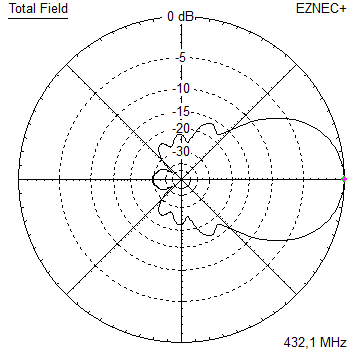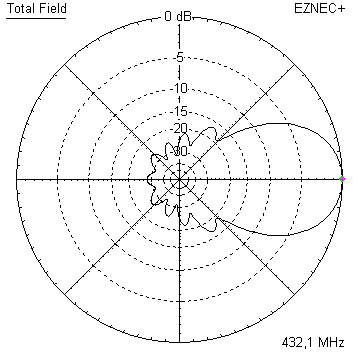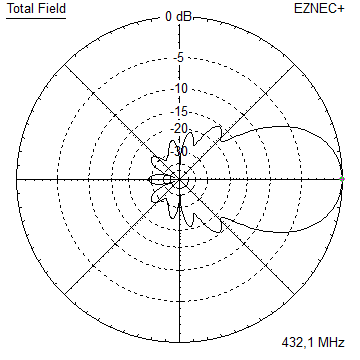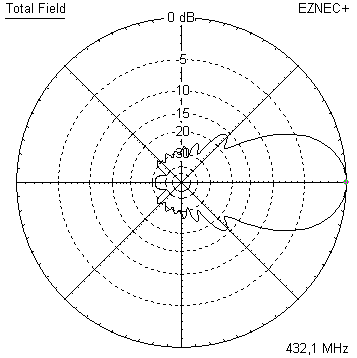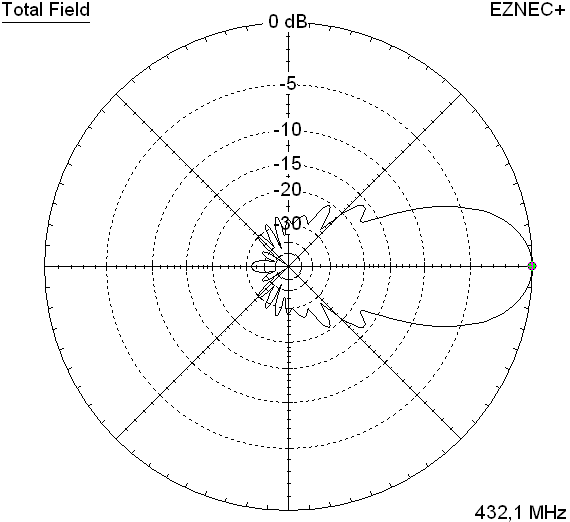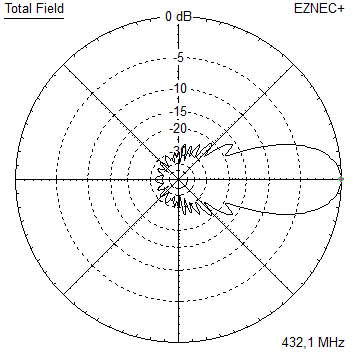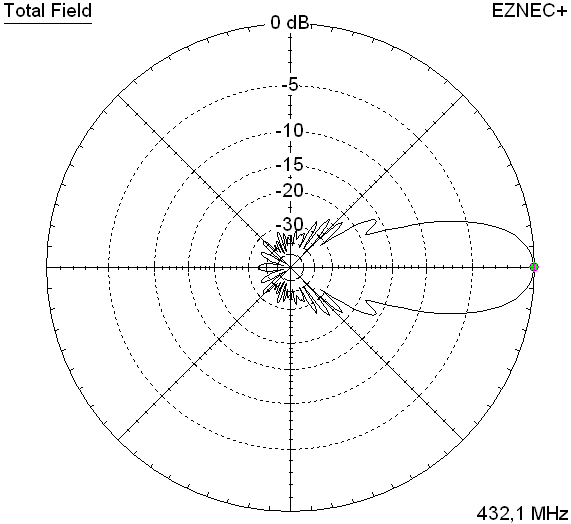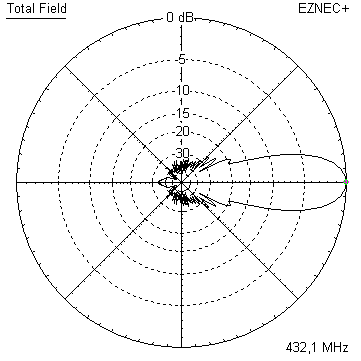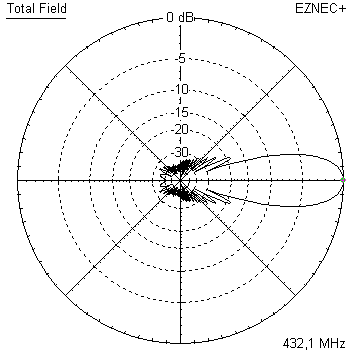
GTV 70-19m Yagi with bent Driven Element
EME + SSB band, with some loss usable for FM up to 435 MHz
4 x vert. GTV70-19m by DB6NT / DK0NA

DB6NT reports: "Auch das SWR ist super bei 1,1 (...).
Das SWR veränderte sich auch kaum, wenn man die Antenne mit dem Gartenschlauch anspritzt.
Die Antenne hat uns einen neuen Standort-Rekord (...) beschert.
Hiermit möchte ich mich und auch alle DK0NA Operators für Deine super
und einfach aufzubauenden Antennen recht herzlich bedanken."
"The SWR is also great at 1.1 (...).
The SWR hardly changed when the antenna was sprayed with a garden hose.
The antenna has given us a new site record (...).
I and all DK0NA operators would like to thank you for your super
and easy to build antennas."
Photo Credit: DB6NT. Tnx Michael!
GTV70-19m built by Leo, RA1WU
This Yagi is built on 20 x 20 mm boom, with 6 mm elements and self made 3 mm Isolators.

The dipole arms are prolonged by approx. 18 mm each against what the drawing of the dipole for elements through boom gives.

Slideshow: 4 x GTV 70-19m 'Blade Dipole' built by John, ZS6JON
as a vertical polarised 4 Yagi bay for EME

GTV70-19m xpol built by Harrie, PE1JXI
This Yagi is built on 20 x 20 mm boom, 6 mm ele. on standard insulators, h/v-plane offset is 395 mm.
Aluminum sheet dipoles from 7array.com.

h/v-pol- Driver cells and 3/4 wl coax stubs with ferrite cores on

Fiberglass struct construction

Feedback: Hallo Harrie, du hattest ein extrem lautes Signal heute Abend auf RS-44. (DL6IAN).
Photo Credit: PE1JXI. Tnx Harrie!
Building table with 6 mm el. on standard insulators see here
GTV70-19m built by Thomas, M0ABA


GTV70-19m built by Koos, ZS6KSG

| GTV 70-19m built by me with 4 mm elements mounted insulated through a 20 x 20 mm boom ... most lightweight and least wind load way of building. Same time lowest cost of materials ... the foundation of your next Contest or EME Array? |

|
The Design and development of the 'Blade DE' is fully described in Dubus magazine 4/2014.
For details on producing a sheet metal bent Dipole see here |

'Blade' Dipole (basically K6STI style but modified with straight middle section and 2 dimensional geometry)

Current distribution

70 cm EME with single GTV 70-19m HB9Q <> DG7YBN with LNA NF 0.3 dB, 280 W out
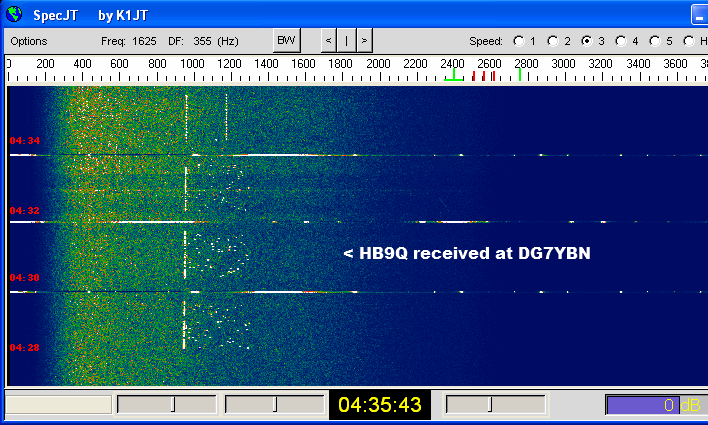

Performance Data
Ele. 8 mm Ele. 6 mm
Gain vs. isotr. Rad. 17.8 dBi 17.8 dBi
Gain vs. Dipole 15.7 dBD 15.7 dBD
-3 dB E-plane 25.0 deg. =
-3 dB H-plane 26.0 deg. =
F/B -31.9 dB -31.5 dB
F/R -29.6 dB -29.4 dB
Impedance 50 ohms =
Mechan. Length 4116 mm =
Electr. Length 5.94 λ =
Stacking Dist. h-pol.
top-to-bottom 1.54 m
side-by-side 1.60 m
Geometry
The 6 mm and 8 mm element fit On-Boom-with-Standard-Insulators style of building.
Segmentation BC and Base BC (see below) must be added.
A simple symmetrising member may be made from a 3 x 1/4 Lambda line grounded at the far side with
N-flange-bushing and an aluminium plate and ferrite added as close as possible to the DE, see below.

This Yagi with 4 mm elements through a 20 x 20 x 2 mm boom

|
Ele. 4.0 mm DE 10.0 mm Boom 20 x 20 x 2 mm |
"Ready to saw and drill" data for mounting elements through boom with BC according SM5BSZ's BC.exe:
Note: with through Boom BC it is important to stick to the boom end offsets given below!
This table is only valid for:
Boom shape: square
Boom dim: 20 x 20 mm
Wall thickn.: 2.0 mm
Holes in boom: 6.0 mm
Offset rear: 30 mm
Offset front: 30 mm
Includes an SBC of 1.83 mm (real SBC plus 0.7 mm for insulators)

This Yagi with 4 mm elements through a 1 x 1 inch boom

|
Ele. 4.0 mm DE 10 mm Boom 1 x 1 x 0.063 in |
"Ready to saw and drill" data for mounting elements through boom with BC according SM5BSZ's BC.exe:
Note: with through Boom BC it is important to stick to the boom end offsets given below!
|
This table is only valid for: Boom shape: square Boom dim: 1 x 1 inch Wall thickn.: 0.063 inch or 1.6 mm Holes in boom: 6.0 mm Offset rear: 30 mm Offset front: 30 mm |
|
This includes a "Segmentation Density Correction" (SBC) of 1.13 mm plus an offset of 0.70 mm per element = 1.83 mm
for compensation of the insulators (7arrays.com
Note: with through Boom BC it is important to stick to the boom end offsets given below!

This Yagi in Imperial Measures with 3/16 in elements through a 1 x 1 in boom

|
Ele. 3/16 inch = 4.763 mm DE 10 mm ... should be easily adaptable to 3/8 inch by adding 2 mm per side Boom 1 x 1 x 0.063 in |
"Ready to saw and drill" data for mounting elements through boom with BC according SM5BSZ's BC.exe:
Note: with through Boom BC it is important to stick to the boom end offsets given below!
This table is only valid for:
Boom shape: square
Boom dim: 1 x 1 inch
Wall thickn.: 0.063 inch or 1.6 mm
Holes in boom: 7.5 mm
Offset rear: 40 mm
Offset front: 40 mm
Includes an SBC of 1.83 mm (real SBC plus 0.7 mm for insulators)
Note: with through Boom BC it is important to stick to the boom end offsets given below!

NEC Geometry for elem. mounted through boom builds:

Metric Measures Versions for On-Boom-Insulators
This Yagi with 6 mm elements on a 20 x 20 mm boom with standard insulators

|
Ele. 6.0 mm DE 10 mm Boom 20 x 20 mm |
"Ready to saw and drill" data for mounting elements on boom with BC according DG7YBN for standard insulators as sold by Nuxcom, WiMo, 7arrays, HFKits.nl:
Includes an SBC of 1.5 mm

NEC Geometry 6 mm ele. semi-insulated on boom ex. BC:
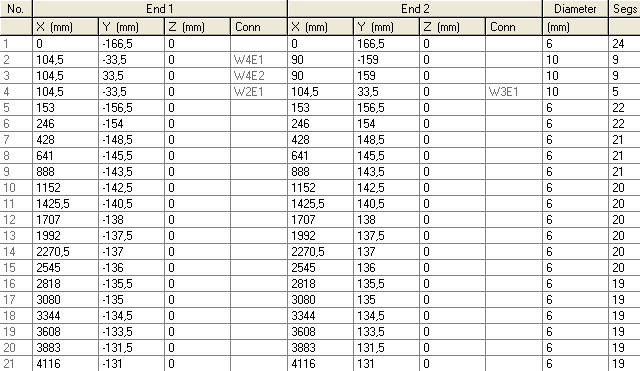
This Yagi with 8 mm elements on a 20 x 20 mm boom with standard insulators

|
Ele. 8.0 mm DE 10 mm Boom 20 x 20 mm |
"Ready to saw and drill" data for mounting elements on boom with BC according DG7YBN for standard insulators as sold by Nuxcom, WiMo, 7arrays, HFKits.nl:
Includes an SBC of 1.56 mm

NEC Geometry 8 mm ele. semi-insulated on boom ex. BC

The Drivers diameter is 10 mm for all examples.
Use EZNEC's Auto-Segmentation at 1050 MHz.
Sketch of Bent Dipole

Details and Return Loss plot of the GTV 70-19m built by ZS6JON

Return Loss without any fine tuning -40 dB @ 432.14 MHz = VSWR = 1.02, Z = 51.0 + 0.2 ohms
and falling towards 432.40 exactly as simulated. Well done John, ES tnx for the photos!

Steps to this achievement:
(1) the application of the through Boom Correction BC.exe, which is SM5BSZ's work,
(2) the YBN Segementation Correction (SBC) is in place,
(3) the plastic insulators influence is taken into account,
(4) the elements are cut to the 10th of a millimetre with help of a calliper gauge,
(5) the 3/4 λ line is trimmed accurately using a VNA
(6) the tolerant 'Blade Dipole' - here we go ...
And with a little honing: Return Loss (S11) - 51 dB @ 432.07 MHz on an Anritsu S332E Sitemaster


Pattern and VSWR Plots
Elevation and Azimuth plot at 432.1 MHz


SWR and Return Loss plots - simulated with 4nec2


Real Return Loss plot (Planar TR1300 VNA - Yagi by DG7YBN with 'Blade Dipole')

This Yagi as XPOL 435 MHz Version
This Yagi with 6 mm elements on a 20 x 20 mm boom with standard insulators

|
Ele. 6.0 mm DE 10 mm Boom 20 x 20 mm |
"Ready to saw and drill" data for mounting elements on boom with BC according DG7YBN for standard insulators as sold by Nuxcom, WiMo, 7arrays, HFKits.nl:
Includes an SBC of 1.74 mm

Downloads
Elem. 4 mm: EZNEC file of this Yagi
Elem. 6 mm: EZNEC file of this Yagi
Elem. 8 mm: EZNEC file of this Yagi
4nec2 file of this Yagi as a 4 bay (8 mm)

Drawing of this Yagis 'Blade' Dipole in 2 mm aluminium sheet metal

Other drawing of this Yagis 'Blade' Dipole in 2 mm aluminium sheet metal
Sketch of Blade DE on Boom

Stacking
As on the 432 MHz Band the Y-factor = T_earth / T_sky is that high I see little chances in
bettering an array's RX performance by using "Over Stacking" distances. However, depending
the level of local QRM it might be worthwhile to try less distance, especially in H-plane.

Stacking Dist. h-pol. DL6WU top-to-bottom 1.54 m side-by-side 1.60 m
Elevation and azimuth plot and data of 4 Yagi bay using DL6WU stacking distances

Gain vs. isotr. Rad. 23.7 dBi Gain vs. Dipole 21.5 dBD -3 dB H-plane, appr. 11.5 deg. -3 dB E-plane, appr. 12.1 deg. F/B -37.7 dB F/R -29.6 dB T_ant 29.5 K* G/T 8.98 dB* Theoretical numbers, no phasing line losses nor imperfections caused by H-frame included *) T_sky = 20 K, T_earth = 350 K as in VE7BQH G/T table
Symmetrising 50 to 50 ohms Feedline to 432 MHz Bent DE
The principle is similar to the 1/4 Lambda coax. Adding 2 x 1/4 Lambda or a half wave line does not change anything but allows
to form a gentle bow below the boom or until behind the Reflector. Follow practical construction hints on "Building a Yagi" page.

 Attenzione!
Take care when lengthening the coax, measure the right length instead of refering to given v-factors only.
Attenzione!
Take care when lengthening the coax, measure the right length instead of refering to given v-factors only.A good choice may be the diam. 5 mm PTFE coax RG-142 B/U: real resonate length (432.2 Mhz as 3/4 Lambda) shield-shield is around 348 mm
 Find more information on Phasing & Matching Lines page
Find more information on Phasing & Matching Lines page 73, Hartmut, DG7YBN








